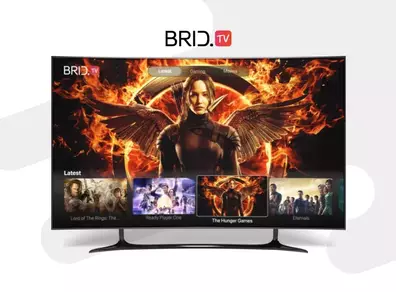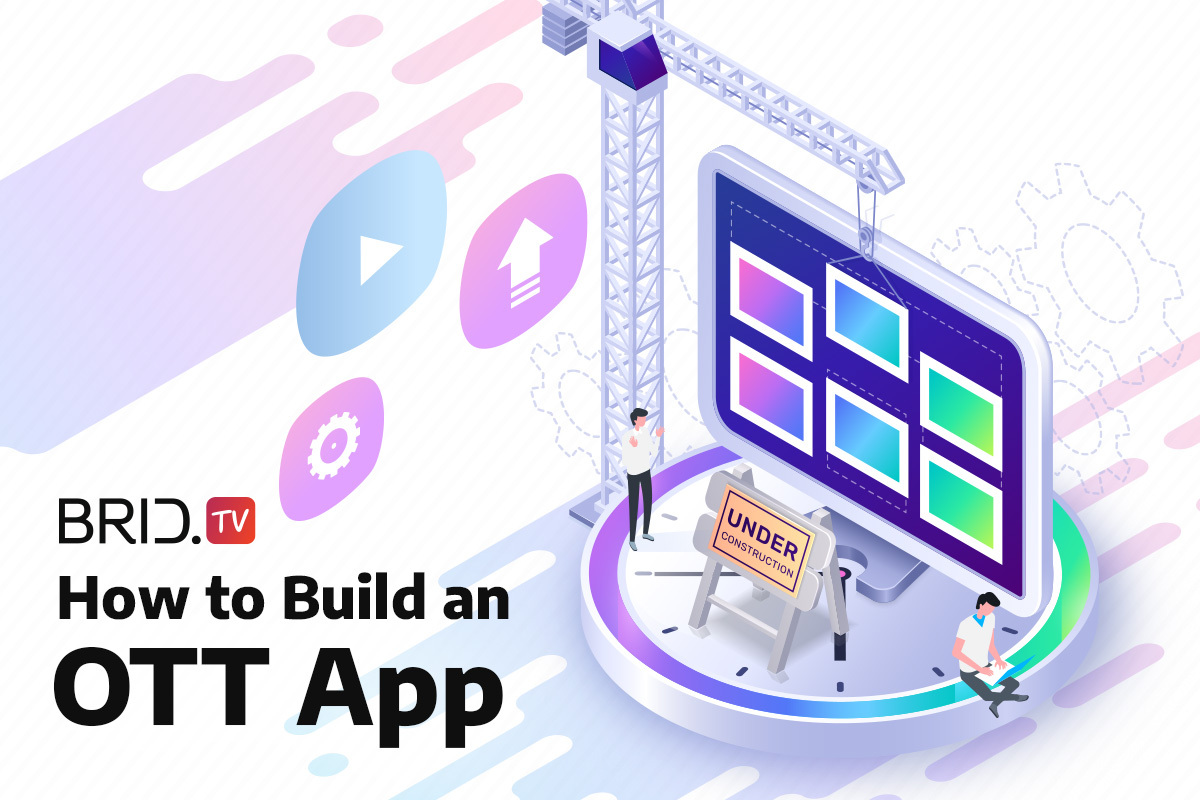If you’re looking for ways to expand your online video business, building an OTT app might be the right step. Although that’s easier said than done, with the right OTT platform, it doesn’t have to be that difficult. Expanding your audience through OTT apps is the first step to scaling your business and eventually generating more revenue. Learn all about why and how to build an OTT app below.
What Is an OTT App?
An OTT app, or over-the-top application, is any app that delivers video content to a viewer’s smartphone, tablet, or smart TV over the internet, as opposed to traditional cable or satellite distribution methods.
These apps help users access their favorite content, such as movies, shows, or even online courses, from a device of their choice and at any time they want. Some of the most popular OTT apps include Netflix, Hulu, and YouTube.
Why Are OTT Apps All the Rage Nowadays?
OTT has become the most popular way of distributing content to your audience in recent years, and it is here to stay. Due to the convenience, variety, and affordability of (most) OTT apps, they are definitely a consumer favorite.
VOD businesses love OTT too, as they enable a wider audience reach and an additional source of income. Research has shown that an OTT app can help a business grow by 30% in a few months.
If you already have a large video website, the next step in scaling your business is to introduce OTT broadcasting to various devices. Don’t look at it as the app replacing your website — more than a third of users still access content from their browsers. On the contrary, consider the app a way to reach new audiences and get your existing consumer base even more invested in your content.

When Is the Right Time to Launch an OTT App?
Have you been thinking about expanding your OTT streaming service to a wider array of devices, but you’re not sure if you’re late to the party? If you ask us, now is the best time to launch your app! Sure, some subscription-based OTT services have been seeing a decline in growth rates, but overall, OTT is thriving. According to Statista, the number of worldwide active OTT users is expected to rise to over 1.6 billion by 2027. The worldwide revenue generated through OTT videos is projected to be at almost $300 billion by the end of 2022.
So how do you go about getting your slice of the OTT pie?
4 Things to Consider Before Building an OTT App
Before we actually get to the app-building part, there are a few decisions to make. For example, you need to figure out how you’d like to monetize your videos and protect your intellectual property. Let’s take a look at some things to consider before building an OTT app.
1. Choose an OTT Monetization Model
There are several ways to turn your OTT content into a source of revenue. For example, your audience can pay a weekly, monthly, or yearly subscription to your platform. They can also only pay for the content they’re interested in. Or you can provide content for free and monetize it through video ads. Let’s take a closer look at the available OTT monetization models.
Transaction-Based Monetization
| Best For |
|---|
| Event live streams, online courses, premium content not available elsewhere. |
Transaction-based video-on-demand, or TVOD, is a video monetization model that encompasses individual transactions for specific pieces of content. The user can pick a movie, show, or another piece of content and pay for access. This access can be completely unlimited (watch whenever and as often as you want) or limited to a specific period or number of views. TVOD is basically the online version of an old-school DVD store.
Subscription-Based Monetization
| Best For |
|---|
| Engaging and educational video content, streaming services with exclusive content. |
Subscription-based video-on-demand, also known as SVOD, is a popular monetization method based on recurring transactions. If you choose this option, your viewers will pay a recurring fee for access to your content. Some of the largest OTT providers out there, such as Netflix, use this monetization model.
However, statistics show that SVOD’s popularity is on the decline, a trend known as The Great Unsubscribe. In short, users are turning away from subscription-based streaming services, as the market is becoming somewhat oversaturated. For the most part, they are doing this in favor of ad-based platforms.
Ad-Based Monetization
| Best For |
|---|
| Businesses and publishers looking to expand their audience, content creators, vlogs. |
Ad-based video-on-demand, commonly referred to as AVOD, creates video ad revenue instead of charging viewers for content. The most obvious advantage of this model is that it comes at no expense to your audience.
In other words, leveraging in-app advertising can attract viewers who simply don’t want to pay for subscription services and don’t mind seeing an occasional ad. In addition to this, as people have been gradually leaving SVOD platforms, they have to look for content elsewhere. So why not get it for free?
OTT advertising has always been quite popular, but lately, it seems to be gaining even more momentum. It allows for quite a bit of customization, as you can choose how much ad inventory to sell, which video ad formats to use, and so on. In other words, you can ensure that the viewer experience remains smooth and unintrusive while still serving video ads and earning money.
You Might Also Like: 10 Best OTT Advertising Platforms for Your Ad-Supported OTT Service
2. Get Licensing for the Content
If you’re planning to stream content on your website that you don’t own the copyrights to, you might need to obtain proper licensing. This is especially important if you’re building an OTT streaming service.
Not all content is copyrighted, but it is up to you to find out if a license is necessary. If you do need a license to stream these videos, you will need to find and contact their owner and request permission to distribute them in writing. Failing to do so could result in the content being taken down or, even worse, legal trouble and hefty fines.
If, on the other hand, you’re building an ad-supported app to distribute your own content, you won’t need to worry about obtaining a license, but you should think about copyrighting your videos.
3. Protect Your Content
Protecting your content from piracy and unauthorized access is paramount if you plan on monetizing it. Think about it — why would anyone pay for access to your videos if they can get it elsewhere for free? The best way to prevent this is to make use of digital rights management.
Digital rights management, or DRM for short, is a technology designed to protect your copyrighted content. It prevents unauthorized distribution and editing, safeguards it from specific IP addresses, geographic locations, or certain devices, disables screen recording, and more.
DRM does this by encrypting digital files. When someone tries to play your DRM-protected video, the HTML5 player contacts your proxy to send a license request. If the user fulfills all criteria (e.g., they have paid for access to the content), the proxy will contact the DRM platform to obtain a decryption key and forward it to the player. Using this key, the player streams the video.
4. Which Devices to Build an OTT App On
The list of devices you can build your application for is quite extensive, from mobile phones and tablets to TVs and OTT boxes. But are all of them worth the effort? Although you technically can build apps for every existing device out there, that is bound to cost you a lot, and it might not even pay off.
A better course of action would be to pick and choose those devices that tend to be the most popular among viewers. Let’s take a closer look at the available options.
First of all, although PC users can access your content through your website, you also have the option to enhance the user experience by building a desktop app. This, however, is not as crucial as making your content available on OTT apps compatible with Android and iOS mobile phones and tablets.
The biggest obstacle of mobile phones and tablets is their relatively small screens. In other words, you also need to put your content on the big screen — OTT TV. This is where things get a little complicated.
If a user owns a smart TV, they can download your Android, iOS, or Tizen app compatible with their device and stream your content easily. However, if their television set is not a smart one, they will need an OTT box or stick. The purpose of these devices is to connect a non-smart TV to the internet and transform it into a connected TV.
There are many OTT boxes and sticks (also commonly referred to as OTT devices) available on the market, but not all of them are equally popular. Some of the best OTT boxes and sticks in 2022 are the Amazon Fire TV, Google TV Chromecast, Roku Streaming Stick, and Apple TV.
How to Create and Launch an OTT App
Now that you’ve decided which devices you want to include in your OTT portfolio, it’s time to actually start building your app. Aside from creating the app yourself (if you have the know-how), there are two ways you can do this.

Hire an App Developer to Build It From Scratch
Your first option is to hire an app developer to build the app for you. There are many developers who specialize in OTT apps, so you can be sure you’re getting the best quality service. What’s more, building an app from scratch this way will grant you complete control over its design and interface.
On the other hand, this method will cost you quite a bit — tens of thousands of dollars. What’s more, the process will take a while. You likely won’t see your app come to life for several months. And lastly, to ensure your app keeps working smoothly, you will likely need to pay a recurring maintenance fee.
Pros:
- Complete control over your app
- High-quality service with specialized OTT app developers
- No skill or knowledge required on your part
Cons:
- Very expensive
- Time-consuming
- Recurring maintenance expenses
Use an OTT Platform
If these numbers are making your head spin, there is a much more affordable and just as good option. You can turn to an OTT platform. These platforms can help you build a custom OTT app for your business for a much lower cost and much faster than an app developer. In addition to this, OTT platforms often come with an array of other features to help you host, manage, and monetize your content.
Choosing the right platform, however, will take some research. First of all, the platform should offer white-label OTT apps, which allow you to use a pre-existing app framework and customize it to your taste and branding.
Some other things to look for in your ideal OTT platform include a video hosting solution, preferably with unlimited storage and built-in video transcoding. A reliable, global CDN should also be available, as well as the monetization options that you have decided to implement. In order to deliver the content, you’ll also need a good, customizable HTML5 player that supports adaptive bitrate streaming. And lastly, high-end security features and detailed analytics are a must.
That being said, the platform you choose doesn’t have to have all of these features. If you find a platform that matches your budget and most of your needs, you might be able to employ a third-party provider to include additional tools. For example, you can get a third-party hosting solution, a hardware video encoder, or a paywall provider.
Pros:
- Costs less than an app developer
- Takes less time to deploy
- All the necessary tools included
- The platform carries out all the needed maintenance
- Readily accessible customer support
Cons:
- Less control over the final appearance of the app
- Requires slightly more work on your part
- Might require third-party integrations
Launch an Ad-Supported OTT App With Brid.TV
You don’t have to look too far to find the right OTT platform. Brid.TV has all the features and tools you need to launch your branded OTT apps on an array of devices. Brid.TV features a robust infrastructure with unlimited private hosting for all pricing plans and built-in transcoding services.
With our Android, iOS, and tvOS SDKs, publishers can serve content on Android and iOS mobile devices and tablets, Android TV, Apple TV+, Tizen, Amazon Fire, Roku, and more! Our white-label app allows publishers to customize OTT apps in their brand’s image and deploy and launch it in no time.
The platform features high-end DRM technology to ensure the complete protection of your content. An extensive video CMS and detailed analytics will allow you to manage and track content performance from a single dashboard.
Lastly, with Brid.TV, you can use instream video ads to monetize content and ensure your audience can enjoy it for free. The platform also features a Marketplace, where you can sell your ad inventory in a few easy steps.
Get in touch to launch a branded OTT app with Brid.TV today!

FAQ
1. What is an OTT app?
An OTT app is any application used to deliver video content over the internet. Some of the most popular OTT apps are Netflix, Hulu, and YouTube.
2. How to create an OTT app?
The easiest way to create an OTT app is by using an OTT platform. These platforms provide all the tools and services necessary for building an OTT app.
3. When is the right time to launch an OTT app?
The right time to launch an OTT app is now! The OTT industry is booming, with more people turning away from cable and satellite TV in favor of online content delivery.
4. What’s the best OTT platform for building an OTT app?
The best platforms for building an OTT app are Brid.TV, Uscreen, and Contus VPlayed. With Brid.TV, you can count on a white-label app with extensive ad-based monetization features, a reliable CDN, top-tier DRM, and so much more.

